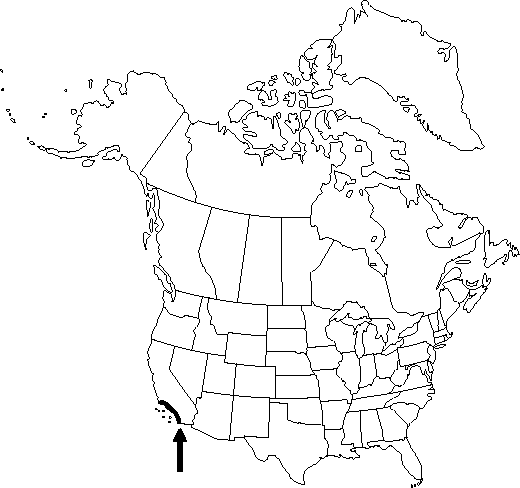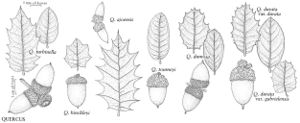Quercus dumosa
N. Amer. Sylv. 1: 7. 1842.
Shrubs, subevergreen, 1-2 (-2.5) m, dense, divaricately branching, leaves brittle, often falling when branches disturbed. Bark smooth when young, eventually scaly. Twigs reddish or grayish, 1-1.5 (-2) mm diam., glabrous or sparsely stellate-pubescent, soon glabrate. Buds reddish-brown, globose or ovoid, 1-2 mm, glabrous, rarely puberulent near apex. Leaves: petiole 1-2 (-3) mm. Leaf-blade undulate or strongly to moderately cupped, occasionally subplanar, 10-20 (-25) × 6-15 (-20) mm, base cordate or angular-cordate, margins irregularly spinose-toothed or shallowly lobed, rarely entire, often somewhat revolute, secondary-veins 3-5 (-6) on each side, irregularly branched, apex rounded or spinose-acute; surfaces abaxially sparsely to densely covered with erect, curly, (2-) 4 (-6) -rayed fasciculate hairs to 0.5 mm, felty to touch in young leaves, adaxially glossy green, glabrate or with scattered stellate hairs, secondary-veins somewhat impressed, puberulent. Acorns solitary or paired, subsessile; cup reddish, deeply cupshaped, 5-8 mm deep × 8-15 mm wide, enclosing 1/3 nut or less, scales long-acute, moderately or scarcely tuberculate at base; nut fusiform or subcylindric, 10-20 (-30) × 5-10 (-12) mm, apex acute. Cotyledons distinct.
Phenology: Flowering spring.
Habitat: Open chaparral, coastal sage scrub
Elevation: 0-300 m
Distribution

Calif., Mexico (Baja California)
Discussion
Of conservation concern.
The name Quercus dumosa has been applied to virtually all scrub oaks in the white oak group of central and southern California and adjacent Baja California. Through the years, and following independent studies by various authors, the concept of this species has gradually narrowed from the original, which included plants here segregated as Q. turbinella, Q. john-tuckeri, Q. cornelius-mulleri, Q. berberidifolia, and Q. pacifica. In degree and constancy, the differences among these species are similar to those separating other commonly recognized tree species of the western United States. The majority of populations referred to Q. dumosa in recent treatments are now included in Q. berberidifolia (see treatment). All of the scrub oaks have a striking superficial similarity because of their shrubby habit and small, often spiny leaves; they differ dramatically in leaf and twig vestiture and acorn form. The concept of Q. dumosa presented here limits it to populations of scraggly shrubs with short petioles, cordate leaf bases, erect curly trichomes on the abaxial leaf surface, and narrow acute acorns that occur at low elevations almost always within sight of the ocean. Because these locations are typically prime real estate, the species, which probably never was common, is highly at risk. It rarely comes into contact with other white oaks because of its low elevation and dry habitat preference; putative hybrids are known, however, with Q. engelmannii and Q. lobata. Some populations of Q. berberidifolia from higher elevations near populations of Q. dumosa show signs of introgression.
Named hybrids include Quercus ×kinselae (C. H. Muller) Nixon & C. H. Muller (= Q. dumosa Nuttall × Q. lobata Née) and Q. dumosa Nuttall var. kinselae C. H. Muller (= Q. dumosa × Q. engelmannii).
The Luisenos used gall nuts from Quercus dumosa medicinally for sores and wounds and as an astringent (D. E. Moerman 1986).
Selected References
None.
